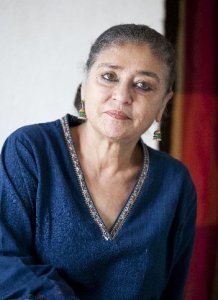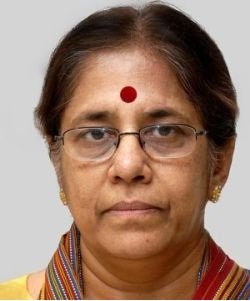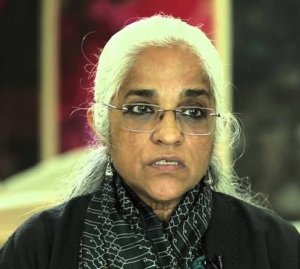
|   |

|   |
 e-mail: leelakaverivenkat@gmail.com 'Her Say' by women theatre directors July 21, 2018 It is heartening that The Raza Foundation's Art Matters series, which so far has been largely concerned with music, dance and painting has finally begun to look at theatre too - perhaps the most dynamic of art expressions along with painting, in terms of being largely engaged with contemporary situations reflecting the thirst and fire of life as lived now. The evening at IIC's Kamaladevi complex termed Her Theatre comprised a panel discussion by well known women theatre directors - Neelam Mansingh, Kirti Jain and Maya Rao. Are women directors different from male directors? Does Her Theatre have gender leanings? Do female directors have a heightened feel for democratization? Has the entry of women directors led to more humanized or more civilized theatre? These are some of the points that Ashok Vajpeyi raised in his introduction.  Neelam Mansingh began by saying that for her after all these years, she still found it difficult to define theatre, which for her was 'mysterious' and 'best able to articulate what I want to say'. While she maintained that one does not like repeating oneself or becoming clichéd, by creating a dejavu or a stereotyped feel in a work, she also quoted T.S. Eliot's remark that nothing is ever new, and that creativity in art is not judged by newness alone. She also remarked in the course of her talk, that while a written play ages fast, she believed that some writers like Hasan Manto dealing with the human situation, never age. Her talk was supplemented by visuals projected on screen. Her idea of theatre was action that was never linear but more circular - with a lot of things happening at the same time. Theatre remains her mirror showing her what she is. But she has no calibrated instrument to navigate her through a work, which through numerous entries and exits looks for what is lost in the fractured identity - for some kind of affirmation or ray of hope. Theatre lies somewhere between illusion, reality and truth. The director looks for the order behind chaos. Neelam does not hesitate to rework the playwright's script. Her memorable productions have been works like Bitter Fruit in 2015 dealing with revenge and with lives lived on the margins, and Girish Karnad's Naga Mandala moving between illusion and reality, of which she was said to be one of the best interpreters. Yerma and Lorca's Blood Wedding were adapted to an Indian milieu, and she is known for the haunting productions based on Hasan Manto's writings 'Dark Borders' though she also said that she would not do Manto again. Having worked for years with traditional Naqqals in the Punjab, and with other groups in Bharat Bhavan, Neelam became very conscious of the power of language and the part it plays in bringing out the location and identity of a play. One thought she would refer to her working at trying to bridge gaps between the rural and the urban. Having worked a lot on the body, she experimented with being guided by what she did not want and then found that in a collaborative approach with actors trying out improvisations, spaces emerged for fresh approaches. While her theatre is overtly political, it is more a mirror of what she feels. That she does not care for woman having to operate within the prescribed societal boundaries is clear from a work of hers like The License where the heroine Neeti who elopes with a tongawala who is killed takes to the profession herself wearing her husband's clothes- when the law authorities thwart her.  Kirti Jain who was Assistant Professor of NSD for theatre history, before becoming its director much later, has been involved with Theatre Pedagogy, driven by a strong conviction that the imagination and creativity demanded in theatre, helps open up a youngster's mind, empowering and helping him make choices for oneself in life rather than always being spoon-fed. She had to search for a theatre style in which she could find herself, after going through the very exacting discipline of NSD training under Abraham Alkazi, the then Director, since she found the Stanislavski 'western style' an imposition from outside - and not reflective of her thoughts. With B.N Karanth taking over later, indigenous traditional styles became part of the exposure - the period throwing up directors like Habib Tanvir, B.V. Karanth, Ratan Thiyam doing a lot of exciting work marrying folk and contemporary theatre with theatre methodology freely dipping into traditional regional art forms. The political landscape of the country going through convulsive situations like the Partition confused - but it also unshackled the imagination for theatre. And instead of the linear, director designed, unidimensional theatre, Kirti Jain discovered alternatives were available and collaborative work, without a fixed text, led to exciting possibilities with ideas coming through non-dramatic texts, and another layering came through dialogue with the actors and improvisations. She got away from the formal proscenium space by going in for participatory theatre. So if a topic particularly occupied her mind, she started reading up and gathering material on it and later picking out one aspect or thread for a work, discussed with writers like Gitanjali to make out a script for her with which she could start working. Rather than being a person involved in women's issues, she as a very political person, (coming from a family which was very political), was inspired to take up issues like Suwarnalatha where a young girl married at nine suffers life in her in-law's house, and work inspired by Urvashi's book. Subjects which provoked her - were the silence surrounding Partition (the way women who went through horrors never talked about them), Baghdad Burning (when she visited Afghanistan and realized what happened in a war torn society to women, Aur Kitne Tukde with America's occupation of Iraq, The Bhookamp (earthquake) or polarities like spirituality and materiality - with a Buddhist mandal and a background chorus. The last person Maya Rao came from an entirely different background - for she came to theatre through Kathakali, being a disciple of Guru Sadanam P.V. Balakrishnan. Unlike the other two directors, hers was solo theatre where she did not work with a whole group of actors. Her penchant had been male roles, and unlike other types of theatre where the persona of the actor is visible, in Kathakali the persona is hidden underneath the makeup and shrouds of material. The body is the expression here and not the face. There were no reference points for her theatre and she had had nobody like a director for 25 years nor did she have any drama school experience and whenever she thought of theatre it seemed to her that the space out there seemed too large for one person. From being a Kathakali performer, her problem was to reinvent oneself. It was like stripping oneself to look inside. The gender issue, for one who had taken on male roles in Kathakali was never a problem. When she created Khol do based on Hasan Manto's work, her dance theatre never for a moment went through a phase of thinking about taking on the role of the heroine - but she automatically chose to build her work round the father who, carrying the dupatta (objects are very important in her work) goes in search of his daughter who has been lost in the riots. When she gets into her rehearsal room, she has the camera constantly bringing into her room the world outside - continual images, in a very reflective way, and it sets her imagination working. She believes in creating a landscape which does not think in terms of characters. Thus when asked to find the masculinity within her, she started working with dough in her hands - its different shapes making her think of different things - entering a zone wherein she is transformed into a world of her own making, where one thinks and acts differently. She thinks of herself as a performer.  In her Ravana, she had to unearth her masculinity - and not the character Ravana as we normally perceive. Objects like a bicycle, a doll - anything - have a history and you are in a space where your imagination is allowed to fly. The disciplining point is to be able to empty your mind completely, so that while entering that other world in this room, you carry no left over impressions of your daily life. Maya says that rhythm is one aspect which influences her a lot - obviously because of her dance background. Again there is nothing linear about her work - or a narrative one can pinpoint. Maya wondered why she had not attempted to look at a transgender phenomenon. When she did Lady Macbeth, her thinking was more on what could have made a woman commit the acts she did. And her reasoning led her to the conclusion that Lady Macbeth was a witch. In the visuals Maya showed, the very strong expressions in each seemed beyond natural - almost super natural - much in the style of what Kathakali tries to evoke. There is no doubt that it is the Kathakali training that has not only given her the discipline, but also spurred Maya to think in the unique way she does. After these theatre personalities had spoken so eloquently, there was little time for an exchange amongst themselves. But some aspects of similarity were obvious. None of them seems to swear by a written play being enacted - so the playwright in this ambience would seem to have lost his pre-eminent place. Even if his theme inspires these directors, his version of the script will be reworked and what ultimately comes out as a production may have many departures from the writer's original. All of them believe in the world of improvisation and collaboration as the best method of discovering new vistas for experimentation. And to think that women directors think of women's issues, is stereotyping them. The liberated woman has transcended gender borders. Formal theatre seems to be giving way to participatory theatre. And linear treatment in theatre is getting to be less exciting.  Writing on the dance scene for the last forty years, Leela Venkataraman's incisive comments on performances of all dance forms, participation in dance discussions both in India and abroad, and as a regular contributor to Hindu Friday Review, journals like Sruti and Nartanam, makes her voice respected for its balanced critiquing. She is the author of several books like Indian Classical dance: Tradition in Transition, Classical Dance in India and Indian Classical dance: The Renaissance and Beyond. Post your comments Please provide your name and email id when you use the Anonymous profile in the blog to post a comment. All appropriate comments posted with name & email id in the blog will also be featured in the site. |